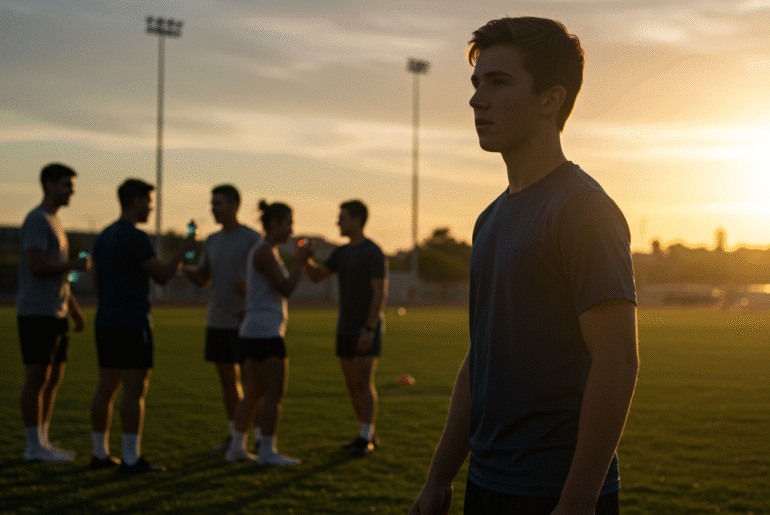This article may contain references to products or services from one or more of our advertisers or partners. We may receive compensation when you click on links to those products or services. Nonetheless, our opinions are our own.
The information presented in this article is accurate to the best of our knowledge at the time of publication. However, information is subject to change, and no guarantees are made about the continued accuracy or completeness of this content after its publication date.
- Introduction
- How Leadership Works in Sports
- What Athletic Leadership Means
- Why Leadership Helps in Sports Success
- How Athletes Can Build Leadership Qualities
- Skills and Tools That Help New Athlete Leaders
- Challenges Athletes Face When Becoming Leaders
- Steps to Develop Leadership as an Athlete
- 10 Traits That Set Great Athlete Leaders Apart
- What Makes Athletes Stand Out as Leaders
- Frequently Asked Questions
- Recommended Reads
Introduction
Leadership in sports is about much more than just being strong or being good at the game. A good leader in sports needs the right way of thinking. You also need to talk well with others, make smart choices, and understand how people feel. A strong leader can inspire others and bring the group together. This is true in single sports and in team play. The way these athletes lead can change not only who wins or loses. It can also change how all the people feel and what the day is like for them. This article gives you a full look at the main traits and ways that make a good sports leader. It talks about how coaching works and how people are expected to act and shows easy-to-follow steps to grow as a leader. This guide is for anyone who wants to get better in sports. It can help you do well, build trust with the team, and help your team get better over time.
How Leadership Works in Sports
Leadership in sports is about finding the right mix between growing yourself and helping others get better. People who lead in sports should be trusted by others, follow rules, and talk clearly with their team. This helps make a place where everyone can do well. Tools like the Leadership Scale for Sports (LSS) look at ways leaders act, such as giving orders, helping others, and leading in a way where people have a say. When athletes and coaches match how they act with what the group needs, the team can come together better. This helps the team work well and do their best. Each team is not the same, so good leaders notice how their teams act. They change what they do to fit these changes. This way, the team can get better results.
What Athletic Leadership Means
Athletic leadership is about more than having a plan or giving orders. It means you have to be steady in what you do, talk to the team, and make sure your actions match what your group wants. A good leader keeps talking openly to others, gives feedback that matches what each person can do, and always takes charge when it comes to their own choices. The way you use leadership can change at every coaching level. Division I coaches often focus on making sure everyone follows the plan. In Division II settings, athletes get more freedom for their choices. Good leaders match how they think and act to fit their coaching style and the feel of the team. This is how you find what works best for everyone.
Why Leadership Helps in Sports Success
Good leaders help everyone work together, talk better, and feel more motivated. Athlete leaders show the group what the goal is and help everyone move toward it. They do this by finding out what each person does well, building strong ties between teammates, and changing their plans when needed to help everyone do their best. Democratic coaches who give feedback and show that they care about how people feel can help build better team spirit. This also helps the team do well for a long time. On the other hand, strict leaders may get fast results, but they can stop trust and growth in the team. Leadership also helps people have the strength to bounce back and keep going. When coaches build trust and get along well with athletes, they feel sure of themselves, get past hard times, and stay focused in the game.
Voted "Best Overall Budgeting App" by Forbes and WSJ
Monarch Money helps you budget, track spending, set goals, and plan your financial future—all in one app.
Get 50% OFF your first year with code MONARCHVIP
How Athletes Can Build Leadership Qualities
Building good leaders starts with learning basic skills. A leader needs to find a style that fits the way the sport works. New leaders should work on understanding their own feelings and those of the team. This will help them know how to act and meet what their teammates need. Social support is very important. In both solo sports and team sports, a leader needs to help everyone show respect to each other. A leader should help build trust and make people feel good about the group’s wins. With better talking and stronger connections, the group becomes more steady and people start to trust each other more.
Skills and Tools That Help New Athlete Leaders
- Emotional Intelligence: The skill to stay calm and care about others’ feelings when you are in a group.
- Communication: Sharing information in an open and clear way so everyone knows their roles and goals.
- Adaptability: Being able to change your style and make choices when things change.
- Support Systems: Getting help through mentors, workshops, and feedback from others.
Mindset Essentials: A strong and steady mindset gets respect and helps get things done. Athlete leaders get a lot from using things like leadership seminars or emotional skills training. These tools help them build a team where everyone works together.
Challenges Athletes Face When Becoming Leaders
People who want to be leaders often find it hard to balance team goals and their own goals. Some common problems they face are
- Managing Expectations: Meeting your own work standards and making sure they match the team’s goals
- Communication Barriers: Problems come up when messages are not clear or when people in the team do not feel connected
- Lack of Support: Feeling like others do not notice, value, or help you when you lead
- Conflict Resolution: Finding ways to solve problems between people in a kind and helpful way
Solutions include regular check-ins, team meetings, feedback, and staying connected with both teammates and coaching staff through feelings and care.
Steps to Develop Leadership as an Athlete
Step 1: Self-Assessment and Goal Setting
Leadership growth starts when you spot what you do well and where you need to get better. Setting SMART goals (Specific, Measurable, Achievable, Relevant, and Time-bound) helps athletes link what they want for themselves and the development of the team. Taking time often to think about yourself, with help from your coach’s feedback, helps you stay on track with your goals. Checking how you are doing now and then can help you stay focused and ready to make changes when needed.
Step 2: Enhancing Communication Skills
Clear talk is key to laying out what should happen and fixing problems. Leaders build trust when they help everyone feel included in talks, support good behavior, and say thank you for what people do. Talking the right way with coaches helps the team use good plans. It also keeps everyone working towards the same goal and helps people grow together.
Step 3: Practicing Accountability
Being accountable helps build trust. Athletes who take responsibility for what they do both when they win and when they lose get respect from their team. They also show how to be disciplined. Getting feedback from coaches and teammates helps you and the group take responsibility. This support makes you try harder and do the right thing.
Step 4: Encouraging Teamwork
True leaders care about shared success. When you work together with your team, you understand each other better. This helps you be more caring and builds trust. Team strength grows best when everyone in the group gets to share their ideas and be noticed for what they bring. Leaders who help the group work well together help people feel like they are one team with the same goal.
Step 5: Learning from Mentors
Experienced coaches, teammates, and alumni have lots to teach. When you see how your mentors deal with hard times, cheer people on, and stay steady, you learn a lot. It helps future leaders figure out their own way to do things.
| Mentor Type | Lesson Shared |
|---|---|
| Veteran Head Coach | Flexibility across changing competition levels |
| Successful Teammate | Emotional support and relationship management |
| Former Collegiate Athlete | Consistency in leadership across different game scenarios |
10 Traits That Set Great Athlete Leaders Apart
- Confidence and Composure Under Pressure: Confidence helps to keep teams steady and lifts their work when things get hard. Calm athletes help others focus on what matters. They also stop people from feeling panicked when a lot is on the line.
- Adaptability and Openness to Change: Leaders have to change their plans and the way they talk to people to fit new situations. Being flexible helps people stay strong and brings new ideas.
- Integrity and Sportsmanship: Honesty, fairness, and respect help to build trust. Leaders who care more about the team doing well than about their own praise can get loyalty and respect from others.
- Vision and Motivation: A clear long-term plan helps the team know what they need to do each day. Motivation helps people feel good and pushes the team to get through tough times.
- Accountability: Taking responsibility for what happens, whether good or bad, shows self-control and helps others respect you.
- Empathy and Emotional Intelligence: When you know how your teammates feel, you can build a better relationship with them. It helps to make a more supportive place for everyone.
- Strategic Thinking: Leaders look at situations fast and make choices that help in the short run and over time.
- Consistency: Being reliable helps people trust you. It also makes sure that you fit in with the team and meet what they expect.
- Inclusivity: Welcoming different points of view helps people think in new ways and brings the team closer.
- Resilience: You need to get back on track after setbacks and keep your focus. This is very important if you want to do well in places where many people are trying to win or do their best.
What Makes Athletes Stand Out as Leaders
Athletic leadership is a skill that comes from steady practice and hard work. It grows when you take time to think, learn from others, and connect with people. When you are aware of your feelings, talk clearly, stay flexible, and stay honest, you can turn into a leader others depend on. This helps you and the people with you get better and go further as a team. Strong leadership turns a group of people into one team that has a clear goal and trusts each other. A good leader can help the team win and help others learn, even when not on the field. A great athlete leader can make a difference that stays with the team for a long time, not just when they win games.
Frequently Asked Questions
What is the most important leadership trait for athletes?
Being sure of yourself is one of the most important traits. It helps keep the team steady. It makes people feel safe to make choices. It also helps everyone stay focused when things get hard.
Can leadership be learned, or is it innate?
Leadership is made up of both the natural qualities people are born with and the skills they learn over time. Coaching, feedback, and mentoring each help a lot in building good leadership skills. Practice and support can make anyone better at leading, even if they did not start out strong. Over time, these traits become habits.
How do athletes balance being leaders and team players?
Finding the right balance in leadership and working with your team takes some real listening, talking, and understanding how others feel. A good leader helps the team and makes sure everyone is working toward the group’s goals. They do not act alone but work with others. This balance keeps the team strong and focused.
Are leadership traits different in individual and team sports?
Yes. In single-player sports, you need to depend on yourself and stay focused in your mind. In team sports, you have to work together, talk to each other, and understand feelings. Both types ask for different leadership skills, but some of these skills can be the same in both. Good leaders adjust to fit what their sport needs.

Reviewed and edited by Albert Fang.
See a typo or want to suggest an edit/revision to the content? Use the contact us form to provide feedback.
At FangWallet, we value editorial integrity and open collaboration in curating quality content for readers to enjoy. Much appreciated for the assist.
Did you like our article and find it insightful? We encourage sharing the article link with family and friends to benefit as well - better yet, sharing on social media. Thank you for the support! 🍉
Article Title: 10 Distinct Qualities That Make Athletes Great Leaders
https://fangwallet.com/2025/07/13/10-distinct-qualities-that-make-athletes-great-leaders/The FangWallet Promise
FangWallet is an editorially independent resource - founded on breaking down challenging financial concepts for anyone to understand since 2014. While we adhere to editorial integrity, note that this post may contain references to products from our partners.
The FangWallet promise is always to have your best interest in mind and be transparent and honest about the financial picture.
Become an Insider

Subscribe to get a free daily budget planner printable to help get your money on track!
Make passive money the right way. No spam.
Editorial Disclaimer: The editorial content on this page is not provided by any of the companies mentioned. The opinions expressed here are the author's alone.
The content of this website is for informational purposes only and does not represent investment advice, or an offer or solicitation to buy or sell any security, investment, or product. Investors are encouraged to do their own due diligence, and, if necessary, consult professional advising before making any investment decisions. Investing involves a high degree of risk, and financial losses may occur including the potential loss of principal.
Source Citation References:
+ Inspo
There are no additional citations or references to note for this article at this time.












































